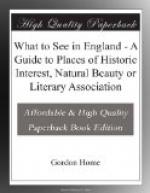The charm of the Norfolk Broads consists to a great extent in the fact that they present different scenery to almost any other county in England, although the salt marshes of Essex and Suffolk possess the family likeness obtaining throughout East Anglia. The Norfolk Broads occupy the stretch of country north of a line drawn between Norwich and Yarmouth, and both towns offer great advantages for getting into the Broad country. A “broad,” it should be mentioned, is a local name for a shallow lake connected with others, and finally with the sea by such rivers as the Yare, the Bure, or Ant. These rivers and their various tributaries form excellent sailing grounds, for after tacking for some time in a rush-fringed river, one suddenly enjoys the contrast of a broad lagoon where there is plenty of space to sail more freely.
The separate characteristics of the different broads give a choice of surroundings capable of satisfying every one. Oulton Broad, for instance, is generally to be found full of smart yachts, while Heigham forms a contrast in its solemn loneliness. Wroxham Broad is always bright with white sails going to or from Surlingham, Rockland, or Salhouse Broads. The last mentioned a beautiful piece of water, the quieter portions of its surface being generally thick with yellow iris and purple loosestrife and many other species of water herb. It is shaded by trees, and makes charming pictures from many points of view. Crome, it is said, commenced a picture of this broad on the day of his death, and anticipated that it would be his best work.
Irstead is another beautiful broad surrounded by feathery reeds and thick with rushes where kingfishers and wild duck are to be found. The ruins of St. Benet’s Abbey are an interesting feature along the river Bure. Within the monastic walls a windmill has been built, and this too is now an old ruin, having lost its sails many years ago.
[Illustration: Photochrom Co., Ltd.
AMONG THE NORFOLK BROADS.
A typical scene on one of the rivers connecting the broads.]
NORWICH CATHEDRAL
=How to get there.=—Train from Liverpool
Station via Colchester.
Great Eastern Railway.
=Nearest Station.=—Norwich. =Distance
from London.=—114 miles. =Average Time.=—Varies
between 2-1/2 to 4-1/4 hours. Quickest train 2
hours 32 minutes.
1st
2nd 3rd
=Fares.=—Single 20s. 6d. ... 9s.
5-1/2d.
Return
31s. 10d. ... 18s. 11d.
=Accommodation Obtainable.=—“Royal
Family Hotel,” “Maid’s
Head Hotel,” “Bell Hotel,”
etc.
=Alternative Route.=—Train from King’s
Cross. Great Northern Rly.




